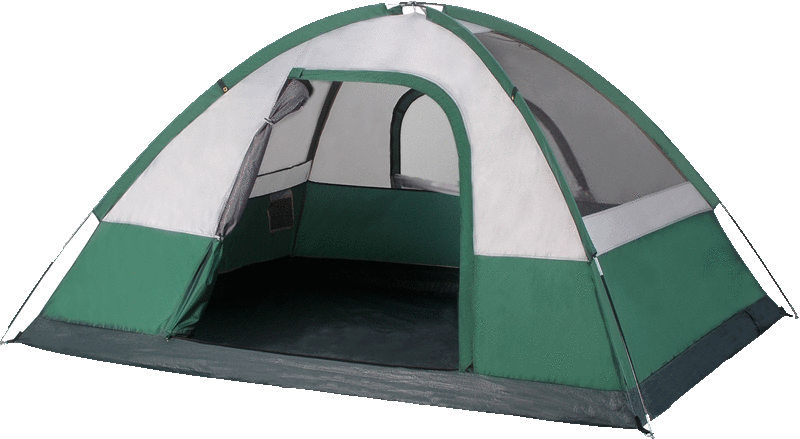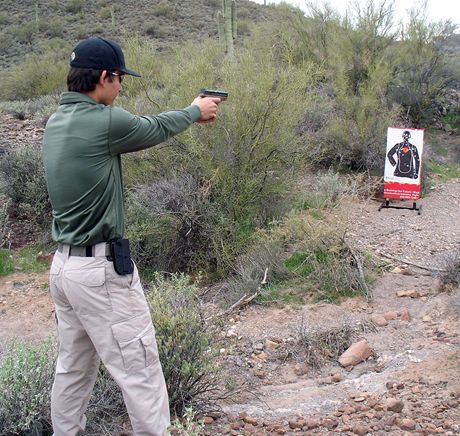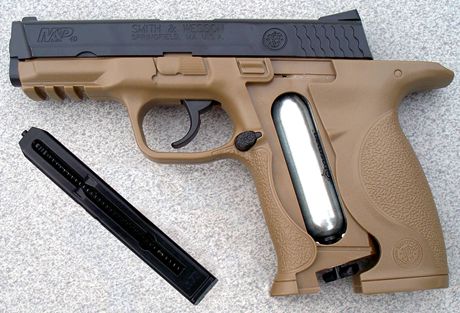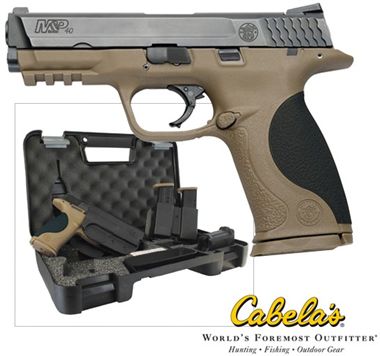Sam has been out to one or two of our Practical Pistol matches in the past,
and to put it charitably, he did not do so well. It certainly didn’t help
that I saddled him with a difficult gun to shoot, a compact, plastic frame
Tanfoglio in .40 S&W. Better known as the EAA Witness-P Compact, this gun
is a plastic framed version of the venerable CZ-75 design. The CZ-75 design
can be fired hammer down in double action with a long heavy trigger pull, or
single action, in which it is carried in the holster cocked and locked.
My normal competition gun is a steel frame, full size, long slide EAA Witness,
again in .40 S&W, that does very well for me. It’s reliable, and I shoot it
well, up to the limits of my modest abilities.
When I brought Sam out with me to his first match, his “training” consisted of
showing him the controls, describing the manual of arms, and letting him
squeeze off a few dry fire rounds the evening before the match. Yes, I know,
shame, shame on me. And to top it off, on the day of the match, the gun
suffered many failures to feed. The fat plastic trigger guard also chafes
your middle finger. It really is not a very comfortable gun to fire.
As more matches came up, I would ask if he wanted to go. He was never much
excited to participate after that. But really, that was the best gun that I
had to offer him from the Martinez armory. No I wasn’t giving up my full-sized
steel competition gun!
As Christmas came up this year, the thought occurred to me that I really would
like to work with him on basic defensive pistolcraft. Despite his lack of
interest in shooting the Witness-P, I sensed that the interest could be kindled
if he had access to a better training tool.
Now I don’t consider myself any kind of an expert pistol trainer, but I thought
that I could at least pass on some of the basics and give him some trigger time
with … a CO2 gun that mimics a popular defensive firearm.
What I found was a CO2 clone of the Smith & Wesson Military & Police 40 (M&P).
Though the package says that it is a Smith & Wesson, it is really made by Umarex,
who builds many well-done CO2 clones of real firearms. It was inexpensive and
looked very cool because it isn’t just another boring black gun. The frame was
in the shade of brown that’s called “Flat Dark Earth”, commonly abbreviated FDE.
The “slide” (which doesn’t really slide on this replica) is black. So overall,
the gun looks like some sort of a “Special Operations” military tool. FDE is
so very tactic-cool these days.
Something like that was not on his Christmas wish list, but that’s one of the
jobs of a Dad, knowing what your kid wants before even he knows it! When he
opened the gift, he was delighted with it.
The standard 19 gram CO2 cartridge loads into the pistol grip. By pulling back
on the grip panel, the area where the air cartridge loads is exposed.
This is a BB gun, not a pellet gun. The 19 round magazine also resides in the
grip and slides up into the bottom just as a firearm magazine would. In size
and shape though, the magazine looks a lot different. The magazine slides up
into the space just in front of the CO2 cartridge. It releases from the gun
with the magazine release button, just like the real deal.
The real S&W M&P 40 is a double-action-only pistol, and the CO2 version shares
the long trigger pull of a DAO action. With a steel slide, the balance and heft
of the piece is also very similar to the real thing. So except for lacking a
loud bang and a recoiling slide, this fun little gun is a very accurate replica
and a great backyard defensive pistol training tool.
There’s a potential problem with shooting BBs in the back yard. Many
Phoenix-area yards, mine included, have cinder block walls. Steel BBs bounce
with very little energy loss off of cinder block walls. They could bounce back
at you, your windows, or your neighbor’s windows. The gun is rated to fire BBs
at 480 fps — that’s pretty fast for a BB pistol. So you need an effective
backstop if you are going to shoot it in civilized areas.
We created a target backer of cardboard overlaid with a carpeting remnant.
The carpet material is very effective at absorbing the BB energy and stopping
them right there. You still must be careful not to miss your target though!
And that wasn’t too hard. The BB M&P proved to be very accurate, shooting to
point of aim even with the fixed sights. The gun is very comfortable to hold.
S&W got the ergonomics right with the M&P. It was a delight to shoot. As you
might expect, it will fire as fast as you can pull the trigger. There is no
stopping to recock with a CO2 air pistol. We were able to get 4 to 5 full
magazines through the gun before it was time to change out the CO2 cylinder.
I was very impressed. In fact, I was so impressed that I started digging
around for info on the real thing. Before getting Sam this CO2 pistol, I
really didn’t have much awareness at all about the S&W M&P. And why should I?
I was quite happy with my EAA Witness and have not at all been in the market
for a new autopistol.
Over the years I’ve watched from the sidelines, wave after wave of new
plastic DAO auto-pistols being introduced, both hammer and striker-fired
designs. The Glock of course is the standard bearer, but it seems that every
manufacturer has jumped onto that bandwagon. But I was never interested, or
even curious about them. Why?
It’s because of that term, “Double Action Only”. One thing I know for sure
is that I can’t hit a darn thing with a revolver in double action mode. But
thumb that hammer back, and I can hit those pistol silhouette rams at 100
yards with a .357 in single action. It’s the same thing when I try to shoot
my Witness from a hammer-down state. The long, rolling trigger pull makes my
gun move all over the place, and that’s exactly where my double action shots
land - any place but the desired point of aim.
However, in single action cocked and locked fire mode with my Witness, I do
alright. When pulling the gun out of my holster, all I have to remember is
to wipe off the safety with my thumb, then a light press on the trigger when
the sights cross the target is all it takes.
If I can’t hit anything in double action, why in the world would I ever have
an interest in a double action only pistol? I figured that there’s a darn
good reason that the 1911, a single action only autopistol design, is still
at the top of the heap for practical pistol competition. The CZ-75 design
is in strong second place only because it has a single action, cocked and
locked mode.
But yet, the new generation of DAO autopistols are flying off the gun store
shelves. Why is that? I think the reasons are self evident. The guns are
perceived to be safer, and because the safeties are automatic, they are easier
to use. Few defensive pistol buyers use them for competition. They are
purchased primarily for defense (imagine that) and for recreation.
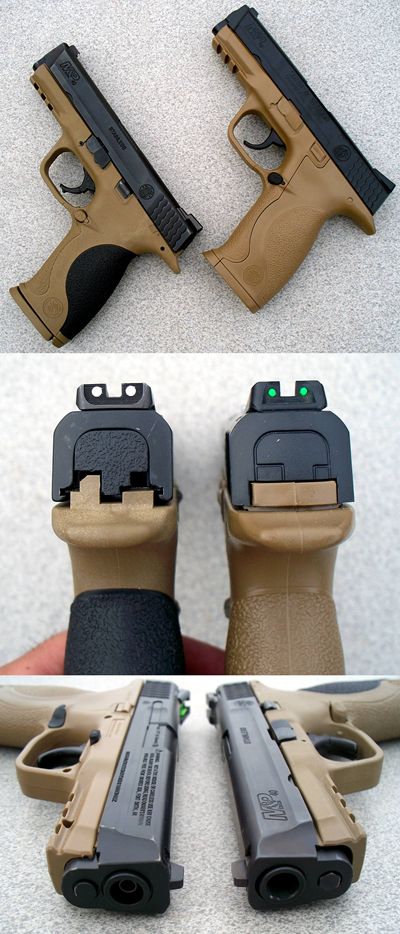
Top: Real M&P on the left, CO2 on the right
Middle: Real M&P on the left, CO2 on the right
Bottom: CO2 on the left, real M&P on the right
|
I have to admit that it does take an extra act of concentration to get my
Witness into the fight (ok, competition). You have to actively think about
pulling the gun, keeping your finger off the trigger, aiming toward the
target, extending the thumb to find the safety lever, flicking off the safety,
verifying sight alignment, and only then touching off the trigger.
I also must admit that I haven’t been 100% successful in performing this
delicate sequence of events. I have had some accidental discharges. Very
rarely, and always down range, but there it is. Plus, this maneuver also
takes time — time that directly impacts your score in this game.
In handing the Witness-P to Sam to use in PP competition, I also must admit
that I did not feel entirely comfortable, knowing that the sequence to get
your first shot on target safely is a little bit complex and works best when
committed to muscle memory. That takes time and many handling cycles which
he did not have.
So after going through this kind of thought process, it started to make a lot
of sense to go ahead and get a real S&W M&P to take Sam’s defensive pistol
training to the next level. The CO2 pistol would give him handling familiarity,
so that when it came time to fire the real thing, all the muscle memory would
transfer over directly. When I bought the CO2 pistol, following up with the
purchase of the real thing was nowhere in my mind. It was only after we worked
with the air gun, that the thought of getting a real M&P became an itch that
had to be scratched. I wonder if this was in S&Ws sales strategy all along in
letting Umarex copy their M&P as a CO2 pistol?
So I started digging around the internet to find out more about the M&P. It
was announced to the market in 2005. I found out that it was featured in the
March 2006 issue of American Rifleman. So I riffled through my back issues
until I found the article. There I learned all the basic details. I won’t
go into all of that here. If interested, you can dig up the info on your own.
Suffice it to say that the M&P is S&W’s answer to the Glock. And to give it
the historic and iconic name of the Smith & Wesson Military and Police model
should tell you all you need to know about how much they think they have hit
the nail on the head with this design. It is not S&W’s first striker-fired
polymer pistol. It’s actually their 3rd generation. The earlier ones, the
Sigma and the SW99, gave them the experience they needed to make this pistol
the one that they could attach the name of M&P.
The scuttlebutt on the internet was almost universally positive. Users
reported out-of-the-box accuracy and absolute reliability. With no red flags,
I was ready to buy. But could we really find one in FDE? Or would we have
to settle for plain boring black?
Browsing the S&W website, it became apparent that the M&P has quite a few
variations. First it comes in five calibers, .22 LR, 9mm, .40 S&W, .357 Sig,
and in .45 Auto. Then there are safety options: No external safety versus
having a frame mounted safety lever. Both with and without a magazine
disconnect safety. Then there are the length variations, compact and standard.
But whoa! What is this? Right there on the S&W website was the “Smith &
Wesson M&P Flat Dark Earth Carry Kit”, available in both 9mm and .40 S&W,
exclusively at Cabela’s. Absolutely perfect.
Full size pistol, no external safety, no magazine disconnect. Comes with a
Blade-Tech Kydex holster, a Blade-Tech double magazine pouch, and a Maglula
Uplula speed loader. Three magazines total, all in a carry case, and all for
a very good price. Everything needed to outfit Sam for Practical Pistol
competition in one stop.
Now let there be no mistake. At 18, he is still too young to legally own a
handgun. The gun is mine and it resides in my safe. But I bought it
primarily for his use. I can’t wait to use it in one of our shoots whenever
he decides he can’t make it out for whatever reason, but he has first right
of refusal. Will I turn it over to him when he turns 21? Maybe, maybe not!
Up until the guy handed it to me at the counter when I was purchasing, I
still had not decided whether 9mm or .40 would be the best choice. In the
end I settled on the .40. It would ease my reloading chores to stick with
the same caliber that I shot. After the M&P came home, I went into production
mode with .40 S&W reloading.
So Sam and I headed out to the desert on our next available weekend to try out
the guns and get in some training. We took out the two S&W M&P 40s (yes, the
CO2 gun says M&P 40 right there on the slide just like the real one), the two
EAA Witnesses, a revolver, and whatever else.
So what about that double action trigger pull? Like the Glock, the M&P’s
striker is mostly cocked by the cycling of the slide. The trigger pull
finishes the striker cock, then releases it. The pull weight is designed to
be around 6.5 pounds with a travel of .30 inches. Again like the Glock, the
safety is built in to the trigger. Instead of a lever inside the trigger face,
the M&P’s trigger is a two piece unit that hinges in the middle.
I found out that the M&P’s trigger pull is nothing at all like I had envisioned
a DAO pull to be. It is not like pulling the trigger on a double action
revolver, or the double action mode on my Witness. As the specs in the
paragraph above suggest, it is very much lighter, and very much shorter. The
first bit of travel feels a lot like the first stage of a two-stage military
rifle trigger. That is, the pull is light and a bit lengthy up until you hit
the “wall” where you know that if you keep pulling, the gun will fire. It is
easy to feel the wall. The .30” travel spec seems to refer to the distance you
must pull the trigger through the wall. It is a very controllable pull. It is
short and light enough that pulling it through the second stage does not upset
your hold on target.
One thing Sam and I learned is that we need to get our own shot timer. We
messed around with a stop watch, but heck, that don’t work.
We set up a defensive type target and practiced doing a sort of single target
combo of the El Presidente and the Mozambique drills. Start with back to target,
spin, draw, and engage with two to the body, one to the head. At first Sam was
hitting pretty consistently low and left. “Here, let me try that.” Bang, bang,
bang. Nope, it wasn’t the gun.
We kept working at it. I noticed that he was shooting with a locked elbow,
leaning backwards slightly. I introduced him to the Weaver stance, with bent
elbow and a leaning-forward posture, knees slightly bent. Surprise, surprise,
that started working for him. I explained how the bent elbow helps to absorb
the recoil straight back, letting you stay on target better. I told him that
no matter what I described, that the technique had to work for him, as everybody
is a little different. Do not overdo the bent elbow, the bent knees, the forward
lean.
So yes, after just one morning of stress-free (competition-free) coaching, he was
hitting quite noticeably better than the first shots fired that morning.
At the recent Zombie match, we didn’t get to shoot a lot of pistol. But Sam
actually surprised himself by easily hitting three pig-headed zombies in rapid
succession with the M&P. Not bad, son. Not bad.

![]()
